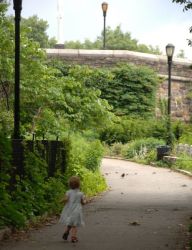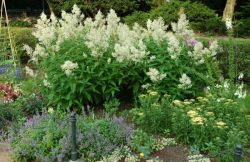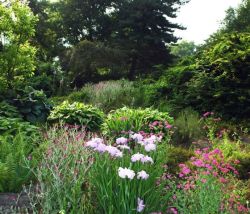Fort Tryon Park
Heather Garden
After John D. Rockefeller, Jr. (1874–1960) began acquiring parcels of land for what would become Fort Tryon Park, he employed the Olmsted Brothers architectural firm to design the park. Frederick Law Olmsted, Jr. (1870–1957), son of the co-designer of Central and Prospect Parks, developed a plan to transform the rocky topography and thin soil of Fort Tryon Park into a stunning landscape that preserved the spectacular vistas of the Hudson River and New Jersey’s Palisades. The Heather Garden was to be a distinct place of beauty and repose within the park itself. Fort Tryon Park and the Heather Garden opened in 1935.
Olmsted built the Heather Garden into the side of the rocky ridge as a series of terraces with American elm trees (Ulmus americana) lining a 600-foot promenade along the top. Stone sitting areas permitted passersby to contemplate the panorama and were purposely set at an angle to minimize noise and visual intrusions. It took several seasons for the garden to mature. Low-growing heather (Calluna vulgaris) was chosen as the predominant plant so as not to obscure the scenery. It is normally found in Scotland and England, where its distinctive pink-purple flowers bloom on the hills during the late summer months.
Time took its toll on the Heather Garden. An ill-conceived 1955 renovation disregarded important aspects of the Olmsted design and by the 1980s the garden had become overgrown, and its magnificent vistas obscured, while little remained of the original plantings. A 1984 report noted, “In its current state, the Heather Garden bears little resemblance to the Olmsted original,” adding that “[t]he current plantings resemble a locomotive of large tennis balls.”
In 1985, Parks undertook a complete renovation of Fort Tryon Park to celebrate the 50th anniversary of its opening. Parks joined with the Greenacre Foundation to restore the park according to the original Olmsted design. The first phase of the project focused on the main terrace and the Heather Garden.
Restoration of the garden was completed in 1988. Thousands of photographs from the 1930s were consulted during the renovation process as well as over 900 drawings and 250 pages of plant listings. As workers removed 20 years of overgrowth, including the invasive Norway and sycamore maple trees (Acer plantanoides and Acer pseudoplatanus) that had taken over much of the area, long-lost views of the Hudson were visible once again. Older shrubs were transplanted and combined with new flora; over 2,500 heathers, heaths, and brooms, 15,000 bulbs, 5000 perennials, 500 shrubs, and five trees were planted.
Check out your park's Vital Signs
Clean & Safe
Green & Resilient
Empowered & Engaged Users
Share your feedback or learn more about how this park is part of a
Vital Park System









